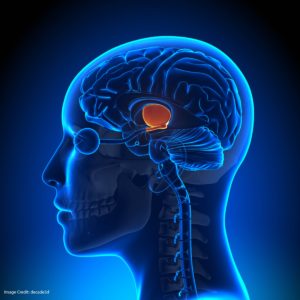The seductive allure of neuroscience often blinds us.
In fact, the image on the right shows the part of the brain — the focal geniculative nucleus — that lights up when we’re taken in by false neuroscience information.
Ok, no it doesn’t.
I’ve just grabbed a random picture of a brain with some color highlights.
And: as far as I know, the “focal geniculative nucleus” doesn’t exist. I just made that up.
(By the way: brain regions don’t really “light up.” That’s a way of describing what happens in an fMRI image. You’re really looking at changes in blood flow, indicated by different colors. Brains aren’t Christmas trees or smokers; they don’t light up.)
And yet, for some reason, a picture of a brain with some bits highlighted in color just makes us go wild with credulity.
The Seductive Allure of Neuroscience: Today’s Research
We’ve known for a while that people believe general psychology research more readily when it includes a picture of a brain.
Is that also true for research in educational psychology? That is, does this problem include research in teaching?
Soo-hyun Im investigated this question with quite a straightforward method. He explained educational research findings to several hundred people.
Some of those findings included extraneous neuroscience information. (“This process takes place in the focal geniculative nucleus.”)
Some also included a meaningless graph.
And some also included an irrelevant brain image (like the one above).
Sure enough: people believed the claims with the irrelevant brain image more than they did the same claim without that image.
In fact, as discussed in this earlier post, even teachers with neuroscience training can be taken in by misleading science claims.
Teaching Implications
If you’re reading this blog, if you’re attending Learning and the Brain conferences, you are almost certainly really interested in brains.
You want to know more about synapses and neurotransmitters and the occipital cortex. You probably wish that the focal geniculative nucleus really did exist. (Sorry, it doesn’t.)
On the one hand, this fascination offers teachers real benefits. For a number of reasons, I think it helps (some) teachers to know more about the process of synapse formation, or to recognize parts of the brain that participate in error detection.
At the same time, this interest confers upon us special responsibilities.
If we’re going to rely on brain explanations to support our teaching methods, then we should get in the habit of asking tough-minded questions.
Why are you showing me this brain image? Is the claim credible without the image?
What does that highlighted brain region have to do with learning?
Who says so? Can you cite some articles?
If the person presenting the information can’t — or won’t — answer these questions, then put down the fMRI image and step away from the research.
The teaching method itself might be sound, but the brain claims behind it are simply relying on the seductive allure of neuroscience.
Like Odysseus, you might be tempted — but do not give in to these neuro-Sirens.




